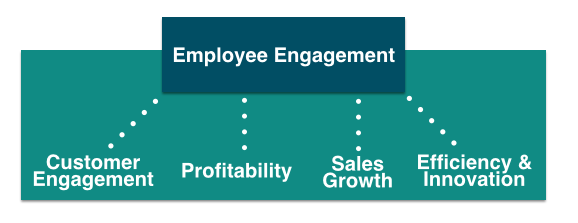Understanding Engagement
The dictionary describes engagement as “the act of engaging or state of being engaged,” but the term is much more complicated in reality. Experts do not agree on what it means in the workplace, or how to achieve it. There is no one-size-fits-all solution, to be sure, but success can be achieved if one understands the currencies of engagement and moves beyond the
Golden Rule to the Platinum Rule.
Some define employee engagement as a state of mind where one feels satisfied, empowered and committed at work. Others suggest it is characterized by such behaviors as persistence and initiative. Still others describe it as innate personal characteristics, like the right attitude, level of energy or point of view. Some define engagement as a combination of all of these. But, confusion over definition cannot distract from the importance of engagement. There is widespread agreement that an engaged workforce leads to higher retention and productivity, lower stress, better customer satisfaction and ultimately results. The cost of not addressing engagement is tremendous. A 2013 Gallup report showed that 70 percent of workers are not engaged or actively disengaged, placing the annual estimated loss in U.S. business productivity at $450-$550 billion.
With so many models for how to improve engagement, which is the best one? Unfortunately, there is no one model for optimizing engagement because not all individuals or organizations are alike.
The 12 Currencies of Engagement
People are like nations—that is, they will accept some currencies, but not others. Even so, some currencies are universally accepted. Examining a cross section of the most popular and researched models shows 12 factors most consistently reported to correlate highly with engagement:
- Engaged leaders and managers and an organizational culture that is nurtured at the top levels.
- Trusted leadership developed by honoring commitments and doing what is right.
- Timely, honest and consistent two-way communication.
- Amiable relationships with immediate supervisors.
- Respectful, collegial relationships with coworkers who do great work.
- Fairness in compensation, workload and negotiations.
- Pride in an organization’s mission, products or accomplishments.
- Appropriate and challenging opportunities for learning and career growth.
- Rewards or recognition for achievements, however small.
- Ability to influence decisions and have some control over the way one’s work is done, scheduled and managed.
- Flexibility in work location or methods, among others.
- Accommodation of personal needs.
This list reflects the most powerful currencies for inspiring engagement. But how do you know which currency or combination of currencies will be most effective? By knowing your audience.
Moving from Gold to Platinum
When it comes to culture and engagement, most thinking stems from the Golden Rule: “Do unto others as you would have them do unto you.” This is a good start, but there is a better way. Leaders must strive for the Platinum Rule: “Do unto others as they would like done unto them.” In other words, don’t assume others want what you want. Treat them the way they prefer to be treated.
In applying the Platinum Rule, we need to embrace the fact that engagement is personal, must be customized and is an ongoing, iterative process highly influenced by fluid dynamics between leaders and followers. This leaves many leaders wondering if it is possible, or realistic, to achieve it. The answer is yes, if leaders prioritize and invest time in relationships and building leadership capabilities.
To build leadership capabilities, consider using Emotional Intelligence as the foundation. Leaders who understand themselves and regulate their own behavior generally are more attuned to what is happening with their people. Ultimately, the leader’s ability to consistently deliver the right currency at the right time determines his or her effectiveness at engagement.
The Platinum Rule begins with active listening. Effective leaders notice that their people constantly communicate their desires through words and deeds. They become attuned to the currencies used by their direct reports and quickly gain insight into how best to engage and keep them motivated. This is where the Golden Rule provides a useful signpost; they probably behave toward others the way they wish to be treated. This method of assessing needs and wants also works up and across the chain of command.
Another approach, so simple that it is often overlooked, is asking people directly. In 2005, Sirota coined the term, “stay interview” to describe an ongoing, informal dialogue where one seeks feedback on the reasons why employees stay, matters that are going well or not and one’s performance as a leader. The goal is to stay connected. The 12 engagement factors can help, but it is essential to recognize that leadership behaviors are meant to drive and shape organizational culture.
Everything a leader does and says, consciously or unconsciously, models what is acceptable or unacceptable. It influences the choices one makes regarding strategy, structure, polices, procedures and their hiring and reward decisions. In short, employee engagement is not a one-shot effort to check off. It is a concerted effort to develop a partnering culture. Once you have learned what currency people want, you need to identify how frequently they want it.
An investment in your people will not go unrewarded. If nothing else, time spent getting to know them will communicate one’s genuine interest in them as fellow human beings, which itself goes a long way toward developing engagement.




